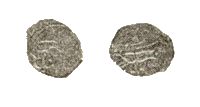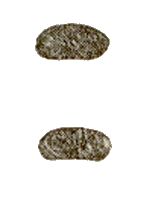1876
-1878 paper money rear face with the
stamp of the ottoman bank. These
stamps on the 1 Lira notes all said " Enregistre par la Banque
Imperiale Ottomane Constantinople. The stamps were created using
metal letters and
printing techniques previously denounced. (recorded by the Ottoman bank -
Istanbul.) they carry the date of 1876 or 1877.

This
note is very important as it clarifies the date of coming into
power of Orhan Gazi, which was disputed in old Ottoman times.
Various
dates from 710=1310 to 727=1327 were alleged about the death of
Osman Gazi, thus coming into power of Orhan. On the other hand,
it was understood from a deed dated 723=1323 that Osman Gazi was
alive at that time, and from another deed dated 724=1324 that
Osman had died in 724 and Orhan had come to power in his place.
Those
coins made it definite that Orhan was the emperor in 724=1324.
No:
1 Silver Coin (AR) AE 18 m/m, 1 g
Front face: Lâilâhe illallah Muham-medün Resulullah
Rear face: Lehu duribe Orhan bin Osman Bursa 3
|

No:
2 Silver coin (AR) 13 m/m, 0,92 g
Front
face: Sultan bin sultan Mehmed bin Bayezid Zide ümrühü
Rear face: Duribe Amasya 812 Hullide mülkühü Han
Mehmed
I (Çelebi) had silver coins printed at several places in
816=1413 with the expression (Sultan bin sultan Mehmed bin
Bayezid Han). While this coin is the same as the coins dated
816, its date is 812, not 816. It is understood that the date
error of this coin is due to the reverse printing of Arabic
numeral 6.
|
|
 No:
4 Silver Coin (AR) 11 m/m, 0,62 g No:
4 Silver Coin (AR) 11 m/m, 0,62 g
Front
face: Sultan Selim Han Bin Bayezid Han
Rear face: Azze nasrühü duribe Harput sene 917
 No:
5 Silver Coin (AR) 12 m/m, 0,55 g No:
5 Silver Coin (AR) 12 m/m, 0,55 g
Front
face: Sultan Selim Şah bin Bayezid, sene 668 Ruha
Rear face: Azze nasrühü
These
belong to Selim I. Selim succeeded to the throne on 918=1512.
However, the coin no. 4 bears the date 917. Since Sultan Selim
became the emperor on 24 April 1512 = 7 Safer 918, it is
understood that the date of 917 was falsely printed on the coin
no. 4. It should be accepted that the numeral 8 in the old
writing was written reverse on this coin and formed a 7.
|
|
 This
coin is a golden coin of Süleyman I (Kanuni). It was printed in
Jeddah. It reads (Süleyman bin Beyazid). Süleyman I assigned
the name of his grandfather Beyazıd Khan on this coin as
well. Different from other coins, it bears the expressions of
"lillah" on its front face and "el-izzi" on
its rear face. Jeddah is a large city at the coast of the Red
Sea and is also the harbor of Mecca. This
coin is a golden coin of Süleyman I (Kanuni). It was printed in
Jeddah. It reads (Süleyman bin Beyazid). Süleyman I assigned
the name of his grandfather Beyazıd Khan on this coin as
well. Different from other coins, it bears the expressions of
"lillah" on its front face and "el-izzi" on
its rear face. Jeddah is a large city at the coast of the Red
Sea and is also the harbor of Mecca.
No:
6 Golden coin (AV) 18 m/m, 3,55 g
Front
face: Daribün nadri lillâh sahibül izzi vennasri filberri
velbahr
Rear face: Es sultan-ül izzi Süleyman bin Selim bin,
Bayezid Han azze nasrühü duribe Cidde sene
|
|
 This
is a coin of Süleyman I (Kanuni). This coin was printed in
Balya. Balya is a town of Balıkesir province and no coin
printed in Balya was encountered until now among the Ottoman
coins. In the book of Peter Jaeckel published in 1968 in
Wiesbaden, showing the coining locations, the names of this city
and town are not included. In this regard, Jeddah and Balya are
added in the list of coining places of Ottoman coins. This
is a coin of Süleyman I (Kanuni). This coin was printed in
Balya. Balya is a town of Balıkesir province and no coin
printed in Balya was encountered until now among the Ottoman
coins. In the book of Peter Jaeckel published in 1968 in
Wiesbaden, showing the coining locations, the names of this city
and town are not included. In this regard, Jeddah and Balya are
added in the list of coining places of Ottoman coins.
No.
7 Silver Coin (AR) AE 13,5 m/m, 0,70
Front
face: Sultan Süleyman Şah bin Selim Han Balya sene 926
Rear face: Azze na (srühü) duribe
|
|
 This
is a coin of Sultan Süleyman I. In the catalog called Meskükât-ı
Osmaniye of Halil Ethem, there is an explanation as (in a
private collection another Aleppo copper coin dated 934 was seen
an its front face read "sikke-i sahib-i zaman" its
rear face "azze nasırühü duribe Halep 934") on
this coin. Although the drawing of this copper coin is not good,
it is legible. This coin was not encountered in other catalogs. This
is a coin of Sultan Süleyman I. In the catalog called Meskükât-ı
Osmaniye of Halil Ethem, there is an explanation as (in a
private collection another Aleppo copper coin dated 934 was seen
an its front face read "sikke-i sahib-i zaman" its
rear face "azze nasırühü duribe Halep 934") on
this coin. Although the drawing of this copper coin is not good,
it is legible. This coin was not encountered in other catalogs.
No.
8 Copper Coin (AE) AE 12 m/m, 3,05 g
Front
face: Sikke-i sahib-i zaman
Rear face: Azze nasrühü duribe
|
|
 This
is also a coin of Sultan Süleyman I and printed in
Constantinople. However, although the date is generally 926 in
the coins cut in Constantinople, the date on this coin is 962.
It is concluded that this coin was also falsely made, and the
order of the numerals 2 and 6 were written wrong. This
is also a coin of Sultan Süleyman I and printed in
Constantinople. However, although the date is generally 926 in
the coins cut in Constantinople, the date on this coin is 962.
It is concluded that this coin was also falsely made, and the
order of the numerals 2 and 6 were written wrong.
No.
9 Silver Coin (AR) AE 12 m/m, 0,75
Front
face: Sultan Süleyman Şah bin Selim Han
Rear face: Hullide mülkühü duribe Kostantaniye 962
|
|
 This
is a silver coin of Selim II. It is the only coin printed in
Hudeyde. No similar coin was encountered in the catalogs until
now. This
is a silver coin of Selim II. It is the only coin printed in
Hudeyde. No similar coin was encountered in the catalogs until
now.
No.
10 Silver Coin (AR) AE 10 m/m, 0,58 g
Front
face: Sultan Selim şah (bin) Süleyman Han
Rear face: (Azze) nasrühü duribe Hudeyde
|
|
 This
coin is a silver drachma of Murad III printed in Baghdad. It has
a Grand Seal and inside the seal "Gazi" is written. This
coin is a silver drachma of Murad III printed in Baghdad. It has
a Grand Seal and inside the seal "Gazi" is written.
No.
11 Silver drachma (AR) AE 18 m/m, 2,95 g
Front
face: Tuğra han azze nasri.ihü (duribe) Bağdat
Rear face: Sultan Murad Han Gazi bin (Selim)
|

This
coin is also a copper coin of Murad III. It was printed in 982
in Erzurum. On its rear face, there is a star with six corners
inside Mühr-ü Süleyman (Cachet de Salomon). Although no name
is written on either face of the coin, it is of Ottoman copper
type and its date corresponds to the throne of Murad III.
No.
12 Copper coin (AE) AE 16 m/m, 1,40 g
Front
face: (In the middle) Erzurum, ((In the periphery) Duribe
982
Rear face: Star with 6 corners inside Mührü Süleyman
|
|
 This
coin is a golden coin called Rumî, printed in the 13th year of
the reign of Mahmud II (Adlî). Having been printed in the 13th
year of the reign constitutes the characteristic of this coin.
Because it was known that the Rumî golden coins were printed
from the 9th year until the end of 12th year of the reign of
Mahmud II. No similar golden coin printed in the 13th year of
the reign was encountered up to now. This
coin is a golden coin called Rumî, printed in the 13th year of
the reign of Mahmud II (Adlî). Having been printed in the 13th
year of the reign constitutes the characteristic of this coin.
Because it was known that the Rumî golden coins were printed
from the 9th year until the end of 12th year of the reign of
Mahmud II. No similar golden coin printed in the 13th year of
the reign was encountered up to now.
No.
13 Golden coin (AV) AE 28 m/m, 4,43 g
Front
face: Grand Seal (with a flower to the right)
Rear face: (13) duribe fi Kostantiniye 1223
|
|
 It
was printed with decorative gold called "Pul" at the
time of Sultan Mahmud II. It is estimated that these "pul"s
were used as accessory by women at that time. It
was printed with decorative gold called "Pul" at the
time of Sultan Mahmud II. It is estimated that these "pul"s
were used as accessory by women at that time.
No.
14 Decorative gold - pul AE 5-9 m/m, 0,12 g
Front
face: Mahmud
Rear face: Time
 No.
15 AE 9 m/m, 0,40 g No.
15 AE 9 m/m, 0,40 g
Front
face: Moon
Rear face: Star
|
|
 Although
golden coins printed during the first and second years of the
reign of Mehmed VI (Vahidüddin), the last Ottoman Emperor,
which lasted 4 years, 3 months and 28 days between 1336-1341
(1918-1922), are found, those printed in the consequent years
are very rarely encountered. Although
golden coins printed during the first and second years of the
reign of Mehmed VI (Vahidüddin), the last Ottoman Emperor,
which lasted 4 years, 3 months and 28 days between 1336-1341
(1918-1922), are found, those printed in the consequent years
are very rarely encountered.
No.
17 Golden coin (AV) Fiver AE 34,5 m/m, 35,82 g
Front
face: Grand Seal, Year 3 (500)
Rear face: Azze nasrihü duribe fi Kostantiniye 1336
The
"Ottoman Banknotes and Coins" pages has been compiled
from The book "Osmanlı Bankası Arşivi ve
Tahsin İşbiroğlu Koleksiyonundan Osmanlı
Bankası Banknotları (1863-1914)" (Ottoman Ban
Notes from the Ottoman Bank Archive and Tahsin İşbiroğlu
Collection (1863-1914), Istanbul, 1999.
|
|
| |
|
